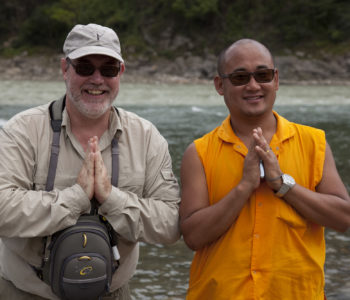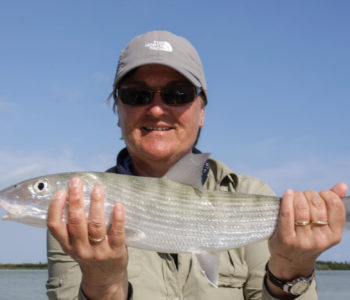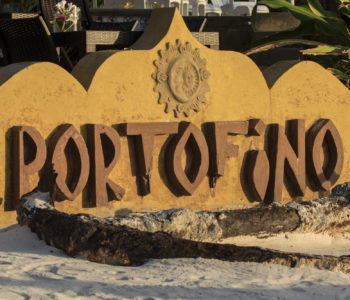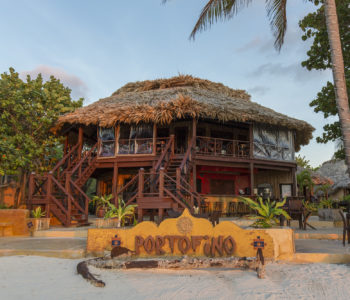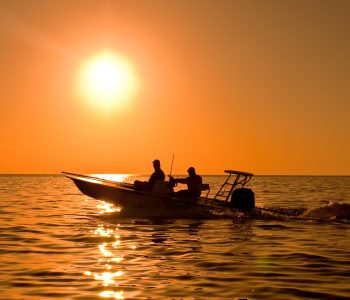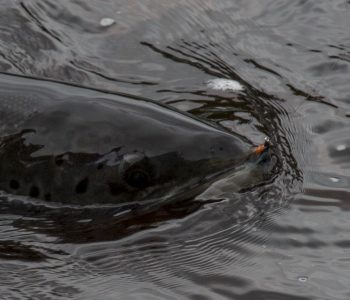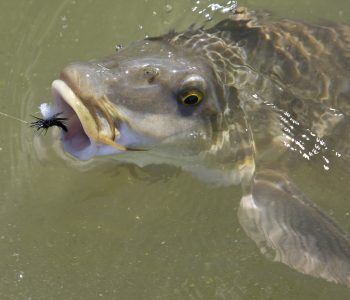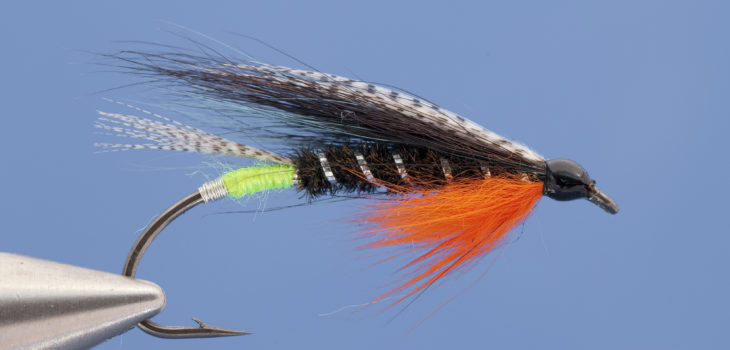
My way with salmon part 2
The Bondal Series
Between 1990-1991 I sent a selection of eight of my first Bondal hairwing patterns to some friends in the USA. Several of the flies where still unnamed. They all loved to fish for Atlantic salmon, especially in Nova Scotia and New Brusnwick. At the end of 1991, I began to receive many very positive comments about the flies. My most memorable one was from my American friend Dick Lemmerman. It seemed he had gone completely crazy over the Bondal Black and it had become his absolute most favourite fly for the Margaree River in Nova Scotia. His enthusiasm and compliments got me to concentrate even more on my hairwing patterns. After seeing the pictures of his catches, I was hard pressed to believe all those nice big fish all were caught with my Bondal black and Bondal silver. He sent pictures of his successes with my Bondal Black for several years in a row. I now know his stories first hand and they indeed are all true. Along the way, Dick took the liberty of renaming my black version of the Bondal fly “The Dutchman’s Balls” and to this day I do not know why he chose that name. He sadly took that secret with him to his grave when he passed away a few years ago. However, that name became so popular that I have to use it myself to prevent confusion when fishing in Nova Scotia.
During this same period, I also received good feedback about two additional dressings of the Bondals series. As a result, I undertook more and more experimentation, which resulted in the evolution and creation of more hairwings. The series has became larger and larger since the first flies were designed and I should also add that the Bondal series led to the inspiration for my Pulsar series as well. My Pulsar flies are salmon patterns with a very special high pulsing effect that is absolutely deadly when water levels are just above normal or really high as well. .
I love a series of flies for trout and grayling and I have even developed a complete series for large predators in salt and fresh water. For Atlantic salmon I probably have more effective flies then I have for trout and grayling altogether. I have given away hundreds of salmon flies over the years, but in a way salmon fishermen are a lot different to anglers who fish a lot for trout and grayling. Salmon flies often don’t work as fast as flies for trout and grayling, so people tend to lose confidence in them and change flies a lot faster. I believe this is why many people thought the salmon flies I had given them weren’t effective.
 A Where Ya-Wannabee-Special
A Where Ya-Wannabee-Special
Today, the complete series of the Bondals contains 30 individual patterns. The big secret behind the major success of my special series of wet salmon flies is that each fly must have caught salmon in at least 15 completely different river systems before I put them in the series. This means that they really have to earn their place. Several flies in the series didn’t have a name at all. I just gave them a number and named only when I ran into something that was worthy of a proper name. Several of these named flies have already created their own incredible story.
The dressings didn’t change much over the years, but the patterns themselves went through some major modifications, as when I tied them on tubes several years ago. My close contact with friends like Dick Lemmerman, Jurij Shumakov and Bob Kenley, surely had a big influence on that decision. After I helped Jurij with a whole range of articles for some of his editorial works, he sent me some of his patterns in return for some further editorial work of mine. I got hooked on his wonderful tube flies immediately, and the way Jurij had tied his new generation of tube flies stimulated me enormously to experiment with tube flies again. The last time I had fished with tubes was somewhere in the late eighties and early ninetees in the Norwegian rivers Orkla and Gaula, when tubes and Waddington’s went through a little reintroduction process as well. Sadly Jurij’s accidently death shocked the salmon world and fly tiers worldwide and all our common plans abruptly came to an end as well.

A few of my Bondal flies from the series
Friends for life
My best with salmon fishing friend is William Stephens (Billy) from Nova Scotia. We met in 1996 for the first time when he guided me at Cape Breton Island. On next to the last day of my trip I landed and released my biggest Atlantic salmon ever. I never use a landing net so I unhooked, measured and released the fish still in the water. This amazing fish was caught in the Long Run pool of the magnificent Margaree River with a 7 weight single- handed rod with 12 pound tippet (maxima). Thanks to Bill’s help and all the tips that I got, I was able to read the crystal clear pools all by myself in no time. Billy told me several times that I did extremely well for the poor fishing conditions in that particular week of 1996. The deadly fly was my Bondal Black, fully adapted to the heat by tying the wing as slim as possible. My way to create low water salmon flies. I also reduced the hook to a size four single hook with down eye. The fish measured 104cm with an estimated weight of between 11 and 12kg. During an amazing week of fishing I had seen the most beautiful rivers in Cape Breton Island and landed two grilse, one salmon and a lot of brook trout in the evenings while experimenting with large deer hair bugs for the first time in my life. The guided tour produced the closest friendship imaginable. Since then we have met every year for fishing and friendship. Meanwhile I have fished some of the Nova Scotia rivers dozens of times, but first since my retirement I am able to fish them also during autumn, but that is an incredible story for another time for sure.

Klink for salmon and for grayling
A few last words about salmon flies
Something else that I want to share with you is the fact that in certain area’s you often see many fish caught with one particular fly. It really is something to think about. How often do we asked other salmon fishermen what flies will work best and do the job and most of us tie on the fly that these people advise to us right away. One day in Newfoundland I saw 12 salmon caught in just a couple of hours by eight different people all using the same fly. It was the Blue Charm and when I talked to the fishermen most of them never use any other fly. So they never know if other flies will do better or worse. It is true most fish are caught on the fly that sees the water the most. I have seen the same happening with the Green Machine in New Brunswick, the Sunray’s Shadow in Norway and Orange Bombers in Labrador. My personal strategy is a little different and when several people advise me to tie on a Blue Charm I purposely will use a completely different fly, especially when the fish have probably seen the same flies over and over again. It works well for me just because fishing isalso believing in your own tied flies, techniques and strategies. Still today in 2015 my research and experiments on Atlantic salmon are not done and I am still learning every trip that I make and every class that do. I am also have the fortune to do a lot of workshops on salmon and during these workshops I can test out and try a lot of different flies. Who of you every tried to test the success of different flies when your catches are really good? What I mean is that I like to change flies when catches are really good and I tell you why: it really gives you more answers and ideas than when you do the opposite, what most people do.

One of the Bondal flies close up: Tony’s first choice (the silver variation)
Just a few lessons learned by experiences and a good observation
From earlier experiences, I have learned that as soon the air temperature gets higher than the water temperature, that is when you can start using dry flies for salmon. It is also used as a rule of thumb by several of my close friends, but when air and water temperature gets too warm it doesn’t work anymore, of course. When in midsummer the water temperatures get too high and the amount of oxygen has dropped to a critical level, most salmon will be hiding in deep lies with their noses down at the bottom and will avoid any activity, to save their strength for their upstream journey and spawning.
I don’t like rules for salmon fishing and I always keep in mind what Lee Wullf once told me: “The only definite thing that you can say about salmon, is that you can not say anything definite about them” and I really believe this strongly.
Another striking lesson that I learned in Atlantic Canada was that fishing rising water was not so good, but from the time it has peaked and started to drop is prime time for many rivers. (In Norway, however, I experienced exactly the opposite; the best wet fly fishing for salmon was during rising water and I caught most fish during these periods). In both places I found dry fly fishing best at normal and low water levels. Personally I like a high but stable water level over a long period because I love it to seek and find the new corridors that salmon take.
During more then four decades of salmon fishing I started with # 9 weight rods but nowadays I mainly use # 6 weights with low water and small rivers and # 7 weights for large rivers or high water. I tried double hand rods many times in rivers like Gaula, Namsen, Nidelva and Orkla but so far I can’t find the joy and satisfaction as I have with light single handed rods. I probably have fished too long and too intense with single handed rods. I don’t advice people starting with a # 6 weight for salmon fishing because you really have to grown into that. I also discover that when you fish light the fish leaps a lot what makes them tired quickly and I can land the fish not only fast but capture a lot of pictures with salmon in air as well.
In general I am a poor caster and therefore my strategy is that I use the wind, the current and special fishing techniques as my most powerful weapons. Special leaders help me a lot in my presentation, while retrieving techniques can help to increase the mobility of my flies and certain knots even boost the wake around my surface flies when needed. I don’t use the Newfoundland or riffling hitch as most people do in Canada and Iceland but have developed my own knot with even more powerful results. Sadly this trick only works with down eye hooks and that’s why I developed a special salmon hook that I can use for bugs, bombers and my Bondal series in the same time. (Daiichi 2110 and 2117) The hooks are very popular in Atlantic Canada. Salmon are not a shy fish but they can refuse all flies when they are stressed and disturbed. The fact that they can be curious and very aggressive at times you will see that back in my way of casting. I learned a lot by good observation and while some salmon will come up for your fly once, others will do it twice or even five times. Sometimes when you know exactly when to change your fly, a salmon is in the mood to come up almost every cast, of course depending in which part of the world you are fishing. When I tell you that we have seen one and the same salmon coming up more than 60 times, I easily can be called a liar again. Grilse can do ever more than that!
When I told people that I caught salmon using nymphs there was again a lot disbelief, but I can assure you that I have hooked a lot of salmon using special nymphs. My first salmon was hooked on a (weighted) Montana nymph in the Stordalselva 1989 during heavy, rising water. I landed five more that morning. Since 1999 I fish frequently with un-weighted nymphs in Atlantic Canada.
In Norway and Russia you can fish for salmon with almost every fly and technique, but in Canada there are a lot of rules that most European people are not familiar with. So in many rivers using doubles or trebles or even weighted flies and sinking or sink tip lines is not allowed. In some rivers you not even allowed to do an upstream cast with wet flies and everywhere you must fish barbless. Most rules are made to prevent poaching and i am not in disagreement with them at all. In fact, I think they made me even more creative and inventive in my approach to salmon fishing.

Ina Stevens playing another very nice salmon in northern Newfoundland
